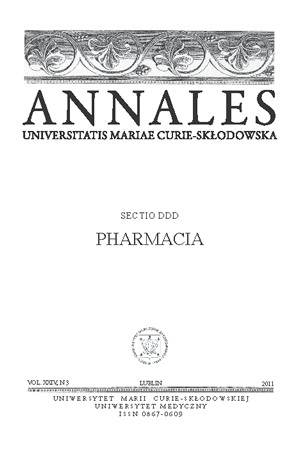Determination of levels of manganese and iron in selected dietary supplements stimulating the immune system of the human body
DOI:
https://doi.org/10.12923/Keywords:
manganese, iron, dietary supplements, flame atomic absorption spectrometryAbstract
In the recent years a growth of an interest in preparations (dietary supplements) which supplement the everyday diet with necessary nutritious and mineral ingredients has been observed. Supplements allow to improve irrational dietary practices, to lower the risk of appearing of illnesses (preventive action), and they also may support therapy. Raw materials of the plant origin being the source of all sorts of biologically active compounds are the components of some of these preparations. Plants contain also a considerable quantity of mineral elements. The purpose of this study was the evaluation of the level of manganese and iron (microelements important for the organism) in selected dietary supplements stimulating the immune system of the human body. The study material was the supplements in the form of capsules and pills - (Acerola Plus, Cat’s Claw, Maca, Maca 50 Plus, Spirulina, Spirulina Hawajska, Spirulina Pacifica, Vilcacora, Żeń-szeń from „Herbapol” Herbal Plant in Kraków, Żeń-szeń – Ginseng (KRKA), Żeń-szeń (Naturell), Żeń-szeń koreański (Walmark), Żeń-szeń (Vita-Complex) and liquid preparations - (Aloes - juice, Aloe Vera drinking gel, Aloes Activ, Aloes Young, Bodymax Tonik, Ginsengin 400, Ginsenol, Noni - juice, Noni-vita, Noni Plus). Samples (3-5 samples of different sort of series of the production of each of supplement) were mineralized “dry” at the temperature of 450°C. Levels of manganese and iron were determined directly from the mineralisate applying adequate parameters of analysis in SOLAAR M5 flame atomic absorption spectrometer. In the dietary supplements in the form of capsules and pills the content of manganese fluctuated on average from 0.16 μg/g (Acerola Plus) to 57.21 μg/g (Spirulina Pacifica) and of iron from 3.43 μg/g (Acerola Plus) to 2262 μg/g (Spirulina Pacifica). In the liquid dietary supplements the values were: of manganese up to 1.58 μg/ml in preparation Aloes – drinking gel and of iron up to 30.60 μg/ml in the juice from noni fruit - Noni-vita. Contents of the studied elements in selected supplements depended on form and composition of preparation. Special predispositions of some plant raw materials were observed, in particular of marine alga - spirulina, as for the accumulation of manganese and iron. Applying dietary supplements containig spirulina, in the maximum twenty-four hour dose - according to indications of the producer, we can provide the amounts of manganese into the organism constituting the recommended 4% of its daily talking and the amount of iron of about 40-50% of the recommended daily consumption of this element.
References
1. Błoniarz J, Zaręba S: Selected microelements (Cr, Zn, Cu, Mn, Fe, Ni) in slimming preparations. Roczn. PZH, 58, 165, 2007.
2. Błoniarz J: Study of some microelements level in selected preparations containing phytoestrogens. Polish J. Environ. Stud., 17 (1B), 18, 2008.
3. Błoniarz J, Zaręba S, Rybak M: Badanie zawartości Zn, Cu, Mn i Fe w suplementach diety zawierających antyoksydanty. Bromat. Chem. Toksykol., 42(3), 760, 2009.
4. Błoniarz J, Zaręba S, Rahnama M: The contents of zinc, copper, manganese and iron in slimming dietary supplements. Monografia “Pierwiastki, środowisko i życie człowieka” pod redakcją K. Pasternaka, Lublin 2009, Pol. Tow. Magnezol., p. 25, 2009.
5. Chuang I-Ch et al.: Determination of trace elements in some natural drugs by atomic absorption spectrometry. Biol. Trace Elem. Res., 76, 235, 2000.
6. Dybczyńki R et al.: Preparation and certification of the Polish reference material „Mixed Polish Herbs” (INST-MPH-2) for inorganic trace analysis. Raporty IChTJ, Seria A nr 4/2002, Institute of Nuclear Chemistry and Technology, Warszawa 2002.
7. Elless MP et al.: Plants as a natural source of concentrated mineral nutritional supplements. Food Chem., 71, 181, 2000.
8. Food and Nutrition Board. Institute of Medicine. Dietary references intakes for vitamin A, vitamin K, arsenic, boron, chromium, copper, iodine, iron, manganese, nickel, silicon, vanadium, and zinc ( 2001), National Academy Press, Washington DC.
9. Jarosz M, Bułhak – Jachymczuk B, (2008), Normy żywienia człowieka. Podstawy prewencji otyłości i chorób niezakaźnych. PZWL, Warszawa.
10. Kłosiewicz-Latoszek L, Tyszko P: Suplementy diety w profilaktyce i leczeniu przewlekłych chorób niezakaźnych. Prob. Hig. Epidemiol., 88, 7, 2007.
11. Leśniewicz A, Jaworska K, Żyrnicki W: Macro- and micro-nutrients and their bioavailability in polish herbal medicaments. Food Chem. 99, 670, 2006.
12. Pinta M, (1977) Absorpcyjna spektrometria atomowa. Zastosowanie w analizie chemicznej. PWN, Warszawa.
13. Roth J: Homeostatic and toxic mechanisms regulating manganese uptake, retntion, and elimination. Biol. Res., 39, 45, 2006.
14. Siah ChW, Trinder D, Olynyk JK: Iron overload. Clin. Chim. Acta, 358, 24, 2005.
15. Stoś K, et al.: Suplementy diety jako źródło składników o działaniu odżywczym i innym fizjologicznym. Żyw. Człow. Metabol., 34, 1036, 2007.
16. Ustawa z dnia 25 sierpnia 2006 roku o bezpieczeństwie żywności i żywienia. Dz. U. z dnia 27 września 2006 r, Dział I. Przepisy ogólne i objaśnienia określeń ustawowych.
Downloads
Published
Issue
Section
License
Copyright (c) 2011 Authors

This work is licensed under a Creative Commons Attribution-NonCommercial-NoDerivatives 3.0 Unported License.


